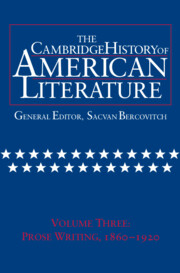Book contents
- Frontmatter
- Introduction
- THE AMERICAN LITERARY FIELD, 1860–1890
- LITERARY FORMS AND MASS CULTURE, 1870–1920
- 1 Museum Realism
- 2 Howells, James, and the republic of letters
- 3 Women and Realist authorship
- 4 Chesnutt and imperial spectacle
- 5 Wharton, travel, and modernity
- 6 Adams, James, Du Bois, and social thought
- PROMISES OF AMERICAN LIFE, 1880–1920
- BECOMING MULTICULTURAL: CULTURE, ECONOMY, AND THE NOVEL, 1860–1920
- Chronology 1860–1920
- Bibliography
- Index
1 - Museum Realism
from LITERARY FORMS AND MASS CULTURE, 1870–1920
Published online by Cambridge University Press: 28 March 2008
- Frontmatter
- Introduction
- THE AMERICAN LITERARY FIELD, 1860–1890
- LITERARY FORMS AND MASS CULTURE, 1870–1920
- 1 Museum Realism
- 2 Howells, James, and the republic of letters
- 3 Women and Realist authorship
- 4 Chesnutt and imperial spectacle
- 5 Wharton, travel, and modernity
- 6 Adams, James, Du Bois, and social thought
- PROMISES OF AMERICAN LIFE, 1880–1920
- BECOMING MULTICULTURAL: CULTURE, ECONOMY, AND THE NOVEL, 1860–1920
- Chronology 1860–1920
- Bibliography
- Index
Summary
THE ORIGINS OF DISTINCTION
William Dean Howells, in an 1887 editorial column for Harper's Monthly, noted that four prestigious American periodicals – The Century, Scribner's, the Atlantic Monthly, and his own Harper's – had all simultaneously published new stories by Henry James. “The effect,” Howells writes, “was like an artist's exhibition.” This “accidental massing” of James's fiction, in other words, reminded Howells of a unique kind of public place, the museum or exhibit gallery: “one turned from one masterpiece to another,” viewing “a high perfection” on display in each one. Howells's trope, comparing published fiction to a museum exhibit, was not in itself unusual. A century earlier, for instance, a New York City serial that included fiction and poetry appeared under the title Weekly Museum (1788–1817). But the assumptions that motivate Howells's trope in the 1880s differ sharply from those that had informed the title of the earlier serial. The New York weekly was a “museum” because it collected for the reader heterogeneous materials of general interest, advertising itself as a “repository” or “assemblage of whatever can interest the mind.” By 1887, however, the figure of the museum no longer connotes eclecticism but rather a consistency of “high perfection,” aesthetic purity rather than diversity. Howells's use of the museum trope, moreover, bespeaks a new kind of cultural authority also absent from the earlier era. By invoking the museum, he claims for fiction the imprimatur of a defining modern institution whose authority is based first and last on the importance of disciplined representation, the specialized exhibition of images and objects. Howells’s analogy draws on the currency of what his contemporary George Brown Goode, director of the Smithsonian, called “the modern Museum idea.”
- Type
- Chapter
- Information
- The Cambridge History of American Literature , pp. 63 - 106Publisher: Cambridge University PressPrint publication year: 2005
- 1
- Cited by

